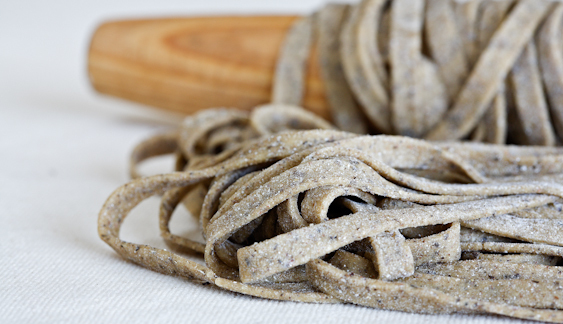Pizzoccheri (Italian Buckwheat Pasta)

introduction
These dark, flat, freckled noodles offer substantial depth of flavor and some heft on the fork. Classically paired with cabbage, garlic, and cheese in the autumnal casserole pizzoccheri al forno, simpler preparations might call for straight Parmesan Reggiano, brown butter, and prosciutto or for toasted walnuts, sautéed shallots, and wilted kale.
Cooking Remarks
We ask that both flours and the eggs be at room temperature before the dough is processed. The buckwheat flour needs hot water to come together properly, and hot water can’t get very far with chilled ingredients.
Pasta recipes can be trying, but this one isn’t bad. The dough goes a couple of rounds in the food processor, a couple more in a simple hand-cranked pasta machine, and then straight through the cutter. It hangs out to dry for a bit and is then cooked off.
These are rustic noodles and aren’t meant to be paper-thin. If you wish, you can roll them out and cut them by hand. Details below. Whether you do this or use a pasta machine, take some care when handling the cooked pasta: buckwheat is not a strong flour and the noodles may break.
equipment mise en place
For this recipe, you will need a food processor, a 2- or 4-cup liquid measuring cup, a quart-size zipper-lock bag, a rolling pin, a bench knife or chef’s knife, a pasta machine or chef's knife, a drying rack (actual or improvised—a wooden rack for drying clothes works extremely well, and a suspended broom handle will do in a pinch), a stockpot, a pair of tongs, and a colander.
-
-
5ounces (1 cup) strong white wheat flour, such as King Arthur Organic Bread Flour or King Arthur European-Style Artisan Bread Flour, room temperature, plus additional for kneading and rolling
-
1teaspoon fine sea salt
-
¼cup hot water, plus additional if needed
-
2large eggs, room temperature
-
1tablespoon table salt, for the pasta cooking water
-
5.2ounces (1 cup) Anson Mills Rustic Aromatic Buckwheat Flour, room temperature
-
-
Place the flours and sea salt in the bowl of a food processor and pulse to combine. Measure the hot water into a 2- or 4-cup glass measuring cup, crack the eggs into the cup, and beat the eggs with a fork. With the food processor running, pour the egg mixture through the tube. Turn off the machine, and then give the dough about ten 3-second pulses. The dough should come together and clear the sides of the bowl. (If it does not, with the food processor running, drizzle in hot water until the dough clears the bowl.)
-
Turn the dough out onto a work surface and knead it lightly for a couple of minutes. If the dough feels dry, dampen your hands. If it feels tacky, flour your hands, but use as little flour as possible. The dough should be smooth and supple. When it is, flatten the dough into a disk, turn it into a zipper-lock bag, and seal the bag. Let the dough rest for 20 minutes.
-
If using a pasta machine: Cut the dough into quarters with a bench knife or chef’s knife. Return 3 pieces to the zipper-lock bag. Lightly flour the fourth piece and with a rolling pin, roll it into a band about 4 inches wide and 8 inches long. Run the band twice through the widest setting of the pasta machine. The dough will now be 12 to 15 inches long and 4 to 5 inches wide. Hang the dough across a wooden drying rack or on a suspended broom handle. A towel rack works nicely as well. Repeat this process with the remaining 3 pieces of dough. Dry the sheets of dough on the rack for about 30 minutes, turning them occasionally.\n\n_If rolling out the pasta by hand:_ Cut the dough into quarters with a bench knife or chef’s knife. Return 3 pieces to the zipper-lock bag. Lightly flour the fourth piece and with a rolling pin, roll it into a band about 4 inches wide and 8 inches long. With a rolling pin, roll out a dough quarter into a 9- to 10-inch square about 3/16 inch thick, flouring as little as possible but as much as necessary to keep the dough from sticking to the counter. Hang the dough across a wooden drying rack or on a suspended broom handle. A towel rack works nicely as well. Repeat this process with the remaining 3 pieces of dough. Dry the sheets of dough on the rack for about 30 minutes, turning them occasionally.
-
If cutting the pasta using the machine: Set the pasta machine to cut fettuccine. Feed the sheets of dough one by one through the machine. Hang the pasta to dry for about 20 minutes—the noodles should be supple and no longer feel fragile. Take the noodles off the rack and lay them, looped gently in half, across a lightly floured baking sheet.\n\n_If cutting the pasta by hand:_ Lightly flour the surface of 1 dough square and loosely roll it up as you would a carpet. Using a chef’s knife, cut ¼-inch-wide coils of dough from the cylinder, taking care not to compress the dough too much. Unroll the coils and hang the pasta to dry for about 20 minutes—the noodles should be supple and no longer feel fragile. Take the noodles off the rack and lay them, looped gently in half, across a lightly floured baking sheet.
-
Bring a large pot of water to a boil over high heat. Add the table salt. Gently lower the pasta into the water, taking care not to break the strands. After about 10 seconds, gently stir with tongs. As soon as the water returns to a boil, reduce the heat to medium-high and partially cover the pot. Cook the pasta until tender, but still firm, about 4 minutes. Drain the pasta in a colander.